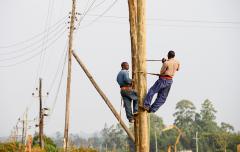Government-provided Energy Safety Nets essential to delivering universal electricity and clean cooking access
How to bring energy access to poor and disadvantaged groups is one of many challenges the world must confront to achieve Sustainable Development Goal 7 (SDG7). A new body of research by Sustainable Energy for All (SEforALL) and its key partners argues that national governments are uniquely positioned to target populations most in need of energy services and provide safety nets for those living in energy poverty.
SEforALL, the Overseas Development Institute (ODI) and the Catholic Agency for Overseas Development (CAFOD) developed Energy Safety Nets as a first-of-its-kind research series to inform best practices at the intersection of energy policy and social assistance to protect very poor, vulnerable and marginalized people.
“To achieve universal energy access, we must close the affordability gap and put the poor first. Public finance and governments play a key role in bridging this gap to connect poor and vulnerable populations to modern energy services they can afford,” said Damilola Ogunbiyi, CEO and Special Representative of the UN Secretary-General for Sustainable Energy for All and Co-Chair of UN-Energy. “Governments can use this research to inform and design effective Energy Safety Nets – helping to improve both people’s welfare and further progress on SDG7.”
Energy Safety Net is a term describing government-led approaches to support the very poor and vulnerable to access essential modern energy services (electricity and clean fuels and technology for cooking). They close the affordability gap between market prices and what poor consumers can pay for both connections and service delivery tariffs, ensuring that households or social groups are not left behind in progress to meet the SDGs.
Many countries around the world have implemented Energy Safety Nets in different forms; SEforALL and its partners examined existing approaches in Brazil, Ghana, India, Indonesia, Kenya, and Mexico to identify lessons learned and pitfalls to avoid for the sake of informing future development of Energy Safety Nets.
Insights from each of the six country case studies were compared and then synthesized into the Energy Safety Nets: Using Social Assistance Mechanisms to Close Affordability Gaps report and an accompanying guide Guide for Policymakers. This analysis revealed five main takeaways for policymakers to consider when designing their own energy-focused social assistance mechanisms.
- Connections and consumption: Household connections to a local mini-grid or LPG system, for example, do little good if an individual cannot afford the energy they provide over the long run. Distinct approaches are needed to support energy connections (e.g., wires and transformers, LPG stoves) and ongoing consumption (e.g., monthly electricity bills and regular fuel consumption).
- Targeting mechanisms: The type of subsidy delivered and the mechanism for delivering it will impact an initiative’s effectiveness. ESNs must be designed to target specific groups while being mindful of their energy needs, including the different needs of women and men. The mechanism (administrative or self-selected targeting) and the benefit (electricity or cooking support) must reflect the main objective of the program.
- Data improves targeting: A lack of evidence on energy consumption within vulnerable households prevents policymakers from determining appropriate thresholds for subsidies. Additional data collection on the specific energy needs of the poor, building on examples such as the Multi-Tier Framework surveys and increasing knowledge on gendered energy usage, would enhance program design and allow policies to be more efficient.
- Flexibility needed: Energy Safety Nets should be appropriate to the country’s institutional, geographic, economic and social context, including efforts to promote gender equality. They must also be adaptable to changing social and economic and social conditions and to lessons learned through implementation.
- Political commitment: The success of Energy Safety Nets depends on strong, multi-year political commitment. National-level pledges to achieve universal energy access, supported by policy commitments to social assistance for the poor and disadvantaged groups, may be necessary to ensure universal energy access goes beyond energy connection targets and includes essential energy consumption levels.
With limited public resources available, it will be critical to maximize the efficiency of Energy Safety Nets benefiting the poor. A process map for building an Energy Safety Net is included in the Guide for Policymakers, helping governments make sense of all the key considerations that must be part of their designs.
One of the opportunities for added efficiency highlighted by the process map is for governments to integrate Energy Safety Nets with their existing social assistance mechanisms or social safety nets. Existing programming in support of the poor can offer valuable data on who can (or cannot) afford energy services, helping improve targeting of energy subsidies. Meanwhile, existing programs may also have their own delivery systems that can also be used for supporting energy connections or consumption.
The Energy Safety Nets research series includes Energy Safety Nets: Using Social Assistance Mechanisms to Close Affordability Gaps, a Guide for Policymakers, six country case studies and six policy briefs offering concise policy analysis for each of the six countries examined.
The country case studies will be released as follows: Kenya, 19 February; India, 20 February; Brazil, TBD; Indonesia, TBD; Mexico, TBD; and Ghana, TBD.
Follow the release of the country cases on social media using #EnergySafetyNets.
You can also register for the upcoming webinar “Key findings of the Energy Safety Nets research series” on 5 March.




